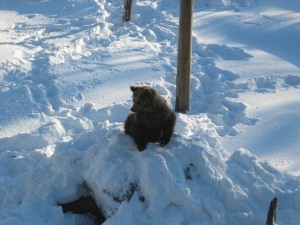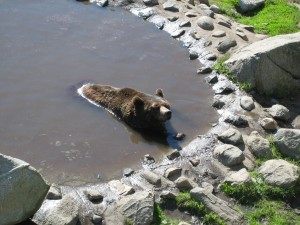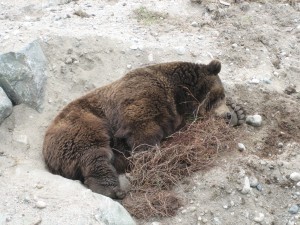When I visit the zoo during the winter seasons one animal is not to be seen at all. That is the brown bear. The brown bears in the nature are sleeping winter hibernation during the winter, and so are the brown bears in Ranua zoo. They use to go to sleep in November and wake up in the beginning of March. This year the brown bears woke up already in February. The staff in the zoo thinks the early wake-up is caused by the big amount of visitors who came to look at the polar bear cub, Ranzo, and the noise spread in to the dens of the brown bears. Read more about Ranzo in my post about the polar bears. Here is a link from Jehu’s first meeting with the snow in 2011.
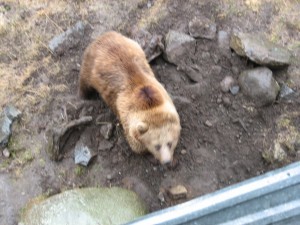
I visited the zoo in the beginning of May. At the moment there are three brown bears living in Ranua. They are the old Palle-Jooseppi and his son Jehu, 3 years old. Last spring Jehu got a girlfriend from another zoo in Finland, the Ähtäri zoo, and her name is Malla. Malla is four years old at the moment. The brown bears get sexually mature at the age of 4-5 years, so the expectations are high there would be one or two cubs in the den next spring when the bears wake up. The cubs are born in January-February. Here is the you tube-link from Malla’s first day in Ranua zoo last spring.
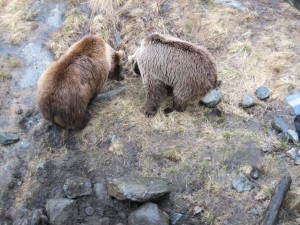 The possibilities for cubs in Ranua zoo next spring are quite high while Jehu and Malla spend a lot of time together and seem to get along quite well. Jehu is at the moment the last brown bear born in this zoo. His mother, Doris, got sick and had to be put to sleep a couple of years ago. After Doris was gone a new female bear, also named Malla, was brought to the zoo. The staff wanted Malla and Palle-Jooseppi to get acquainted to each other and the two bears were put together in the same cage. But it turned out something about Malla irritated Palle-Jooseppi and he hit her and then caused her death.
The possibilities for cubs in Ranua zoo next spring are quite high while Jehu and Malla spend a lot of time together and seem to get along quite well. Jehu is at the moment the last brown bear born in this zoo. His mother, Doris, got sick and had to be put to sleep a couple of years ago. After Doris was gone a new female bear, also named Malla, was brought to the zoo. The staff wanted Malla and Palle-Jooseppi to get acquainted to each other and the two bears were put together in the same cage. But it turned out something about Malla irritated Palle-Jooseppi and he hit her and then caused her death.
Last spring as the new Malla-bear was brought to the zoo she was put together with Jehu immediately. She, however, got a bit scared of Jehu’s interest, so the staff had to put Jehu away for a while to “cool down”. But at the moment there are no problem whatsoever and the two young bears seem to get very well together, while Palle-Jooseppi spends his time alone in his own cage.
The brown bear lives in the forests and mountains of northern North America, Europe, and Asia. The Finnish brown bear lives mainly in conifer forests. The brown bear, which is active during twilight, can also be seen searching for food during the day. Brown bears are usually solitary. The male and the female spend time together during mating season in the summer, and the mother usually lives with its growing cubs until the next cub is born. The female bear gives birth to new cubs approx. every three-year.
Adult brown bears are powerful, top-of-the-food chain predators, but much of their diet consists of nuts, berries, fruit, leaves, and roots. Bears also eat other animals, from rodents to moose. Last week there was a killed reindeer found just about a kilometer from the Santa Claus’ village outside Rovaniemi, most certainly killed by a bear. There is at the moment not so much other food to eat in the forest, unfortunately.
Despite their enormous size, brown bears are extremely fast, having been clocked at speeds of 30 miles per hour (48 kilometers per hour). They can be dangerous to humans, particularly if surprised or if a person gets between a mother bear and her cubs. Almost every year there are reports of bears seen too near habitations in the eastern parts of Finland. People have all reasons to be careful when they see a bear, even though the bears are very neat to look at and every child probably has a beloved teddy bear at home in their bed.
The bears could live to 25 years of age. The adult bears are 5 to 8 ft (1.5 to 2.5 m) tall and weight 700 lbs (318 kg). The male bear is bigger than the female bear.

